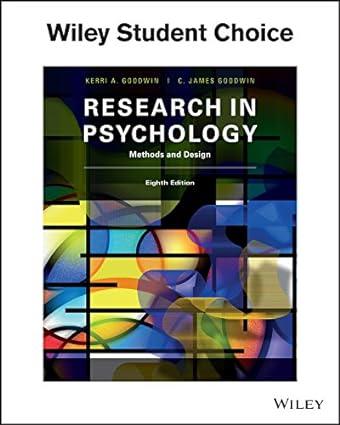For each of the following, identify the independent variable(s), the levels of the independent variable(s), and the
Question:
For each of the following, identify the independent variable(s), the levels of the independent variable(s), and the dependent variable(s).
For independent variables, identify whether they are manipulated variables or non‐manipulated subject variables. For the manipulated variables, indicate whether they are situational, task, or instructional variables. For dependent variables, indicate the scale of measurement being used.
1. In a cognitive mapping study, first‐year students are compared with seniors in their ability to point accurately to campus buildings. Half the students are told to visually imagine the campus buildings before they point; the remaining students are not given any specific strategy to use. Participants are asked to indicate (on a scale of 1 to 10) how confident they are about their pointing accuracy; the amount of error (in degrees) in their pointing is also recorded.
2. In a study of the effectiveness of a new drug in treating depression, some patients receive the drug while others only think they are receiving it. A third group is not treated at all.
After the program is completed, participants complete the Beck Depression Inventory and are rated on depression (10‐point scale) by trained observers.
3. In a Pavlovian conditioning study, hungry dogs (i.e., 12 hours without food) and not‐so‐hungry dogs (i.e., 6 hours without food) are conditioned to salivate to the sound of a tone by pairing the tone with food. For some animals, the tone is turned on and then off before the food is presented. For others, the tone remains on until the food is presented. For still others, the food precedes the tone. Experimenters record when salivation first begins and how much saliva accumulates for a fixed time interval.
4. In a study of developmental psycholinguistics, 2‐, 3‐, and 4‐year‐old children are shown dolls and told to act out several scenes to determine if they can use certain grammatical rules. Sometimes, each child is asked to act out a scene in the active voice (“Ernie hit Bert”); at other times, each child acts out a scene in the passive voice (“Ernie was hit by Bert”).
Children are judged by whether or not they act out the scene accurately (two possible scores) and by how quickly they begin acting out the scene.
5. In a study of maze learning, some rats are given an elevated maze to learn (no side walls); others have to learn a more traditional alley maze (with side walls). The maze pattern is the same in both cases. Half the rats in each condition are wild rats; the remaining rats were bred in the laboratory. The researcher makes note of any errors (wrong turns) made and how long it takes the animal to reach the goal.
6. In a helping behavior study, passersby in a mall are approached by a student who is either well dressed or shabbily dressed. The student asks for directions to either the public restroom or the Wal‐Mart. Nearby, an experimenter records whether or not people provide any help.
7. In a memory study, a researcher wishes to know how well people can recall the locations of items in an environment.
Girls and boys (ages 8–10) are compared. Each is shown a sheet of paper containing line drawings of 30 objects. For half the subjects, the items on the sheet are stereotypically male‐oriented (e.g., a football); the remaining subjects get stereotypically female‐oriented items (e.g., a measuring cup). After studying the objects on the first sheet for 3 minutes, all subjects are then shown a second sheet in which some of the items have moved to a new location on the page. Subjects are told to circle the objects that have moved to a new location.
8. In a study of cell phone use and driving, some participants try to perform as accurately as they can in a driving simulator (i.e., keep the car on a narrow road) while talking on a hand‐held cell phone, others while talking on a hands‐free phone, and yet others without talking on a phone at all. Half the subjects have 2 years of driving experience. The remaining participants have 4 years of driving experience.
Step by Step Answer:






